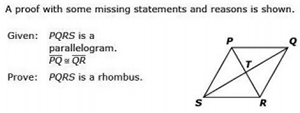Clusters should not be sorted from Major to Supporting and then taught in that order. To do so would strip the coherence of the mathematical ideas and miss the opportunity to enhance the major work of the grade with the supporting clusters.
- Assessment Limits :
Items may require the student to be familiar with similarities and
differences between types of parallelograms (e.g., squares and
rectangles).Items may require the student to identify a specific parallelogram.
Items may assess theorems and their converses for opposite sides of
a parallelogram, opposite angles of a parallelogram, diagonals of a
parallelogram, and consecutive angles of a parallelogram.Items may assess theorems and their converses for rectangles and
rhombuses.Items may include narrative proofs, flow-chart proofs, two-column
proofs, or informal proofs.In items that require the student to justify, the student should not be
required to recall from memory the formal name of a theorem. - Calculator :
Neutral
- Clarification :
Students will prove theorems about parallelograms.Students will use properties of parallelograms to solve problems.
- Stimulus Attributes :
Items may be set in real-world or mathematical context. - Response Attributes :
Items may require the student to classify a quadrilateral as a
parallelogram based on given properties or measures.Items may require the student to prove that a quadrilateral is a
parallelogram
- Test Item #: Sample Item 1
- Question:

Drag the correct statement from the statements column and the correct reasons from the reasons column to the table to complete line 3 of the proof.
- Difficulty: N/A
- Type: DDHT: Drag-and-Drop Hot Text
Related Courses
Related Access Points
Related Resources
Formative Assessments
Lesson Plans
Problem-Solving Task
MFAS Formative Assessments
Students are given expressions that represent the measures of two angles of a parallelogram and are asked to find the measures of all four angles describing any theorems used.
Students are given parallelogram ABCD along with midpoint E of diagonal AC and are asked to determine the relationship between the lengths AE + ED and BE + EC.
Students are given expressions that represent the measures of two angles of a parallelogram and are asked to find the measure of an angle opposite one of the given angles.
Students are asked to explain how to determine whether a four-sided frame is a rectangle using only a tape measure.
Students are asked to prove that a rectangle is a parallelogram.
Students are asked to prove that the diagonals of a rectangle are congruent.
Students are asked to prove that opposite angles of a parallelogram are congruent.
Students are asked to prove that the diagonals of a parallelogram bisect each other.
Students are asked to prove that opposite sides of a parallelogram are congruent.
Students are asked to explain why a pair of triangles formed by the sides and diagonals of a parallelogram are congruent.
Student Resources
Problem-Solving Task
This is a reasonably direct task aimed at having students use previously-derived results to learn new facts about parallelograms, as opposed to deriving them from first principles.
Type: Problem-Solving Task
Parent Resources
Problem-Solving Task
This is a reasonably direct task aimed at having students use previously-derived results to learn new facts about parallelograms, as opposed to deriving them from first principles.
Type: Problem-Solving Task









